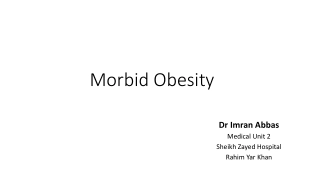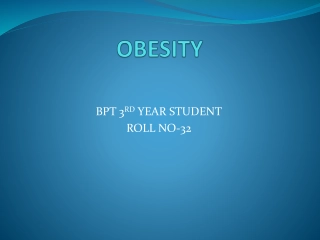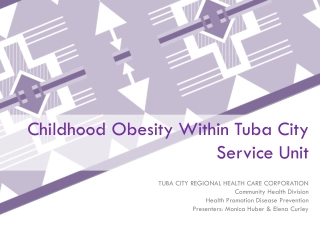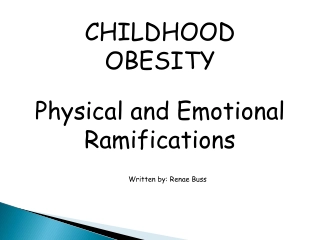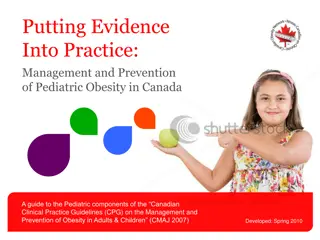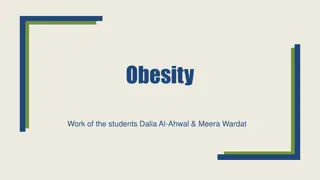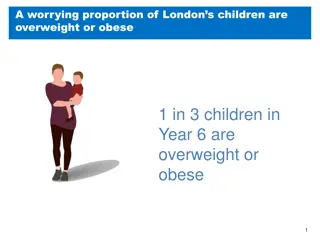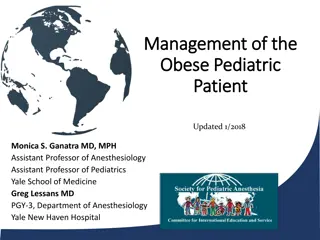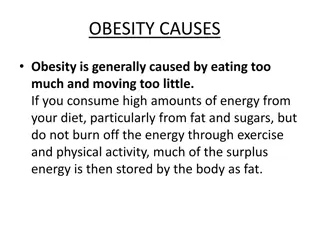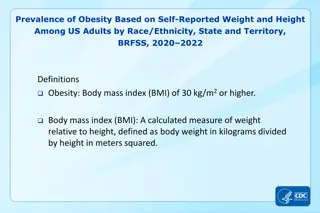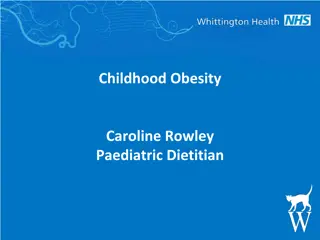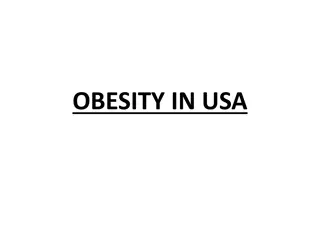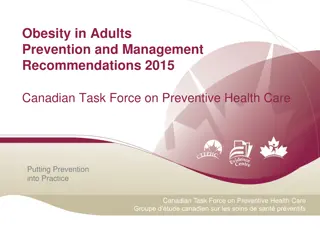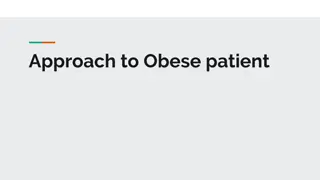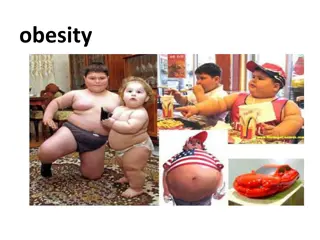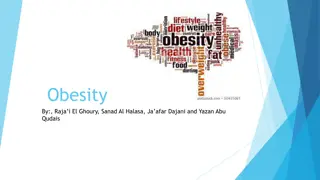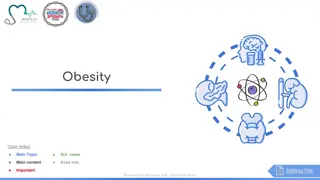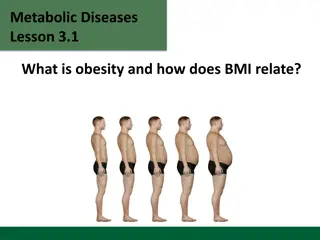Morbid Obesity
Morbid obesity, its definition, BMI, and the pathological consequences it has on health. Dr. Imran Abbas's medical unit at Sheikh Zayed Hospital in Rahim Yar Khan specializes in treating morbid obesity and related health conditions.
0 views • 24 slides
Obesity
Obesity, its causes, and how it affects overall health. Discover the role of factors such as genetics, lifestyle, and eating habits. Explore the prevalence of obesity worldwide and its correlation with various diseases. Understand the measurement of obesity through BMI and its different categories.
2 views • 19 slides
Childhood Obesity Trends in Tuba City: A Health Promotion Perspective
Childhood obesity trends in Tuba City, as presented by Monica Huber and Elena Curley from Tuba City Regional Health Care Corporation (TCRHCC), highlight the importance of health promotion and disease prevention initiatives. The data reveals a concerning rise in obesity rates among school-age childre
0 views • 17 slides
Understanding Childhood Obesity: Physical and Emotional Impact
Explore the physical and emotional ramifications of childhood obesity, addressing key culprits like poor nutrition and lack of physical activity. Discover strategies to decrease childhood obesity, improve wellness, and enhance academics by integrating physical and nutrition education. Gain insights
6 views • 33 slides
Strategies to Address Childhood Obesity and Food Insecurity in Oregon
Various paths to reduce childhood obesity and food insecurity in Oregon are discussed, including the impact of SNAP, soda taxes, and key objectives to focus on. The importance of ensuring interventions do not cause harm over other dimensions is highlighted. The evidence on soda taxes, SNAP program,
6 views • 10 slides
Distribution of Direct Healthcare Costs and Obesity-Related Complications Among High-Cost Individuals Living with Obesity
This UK retrospective cohort study examines the demographic and clinical characteristics of individuals living with obesity who contribute most to direct healthcare costs. The study uses data from the UK Discover database to stratify individuals with obesity into quintiles and assess their contribut
2 views • 12 slides
2023 CPG Obesity Guidelines: Application in Primary Care and Impact on Pediatric Health
Application of the 2023 CPG Obesity Guidelines in primary care is crucial due to the increased prevalence of obesity among children, with 19% affected in the US. This guideline update is necessary as the last guidelines were published in 2007 and there is now more data available, including RCTs and
5 views • 23 slides
Understanding and Combating Obesity: Causes, Consequences, and Solutions
Obesity, characterized by abnormal weight gain, poses serious health risks such as heart diseases, high blood pressure, and joint problems. Genetic factors, lifestyle habits, and lack of physical activity contribute to obesity. Prevention involves maintaining a healthy diet, exercising regularly, an
0 views • 11 slides
Maternal and Fetal Complications of Obesity in Pregnancy
Understanding the impact of obesity stigma as a stressor throughout the lifecourse is essential, especially concerning pregnancy. The prevalence of pre-pregnancy overweight and obesity poses significant risks, leading to various maternal complications like gestational diabetes, cesarean delivery, an
0 views • 62 slides
Understanding Obesity: A Comprehensive Overview
Obesity is a complex health concern that goes beyond appearance. It increases the risk of various diseases like heart disease, diabetes, and cancer. Genetic factors, poor diet, sedentary lifestyle, and mental health issues can contribute to obesity. The consequences of obesity affect physical and me
0 views • 16 slides
Pediatric Obesity Management and Prevention Guidelines in Canada
This resource provides guidance on pediatric obesity management and prevention in Canada, based on the Canadian Clinical Practice Guidelines. It includes recommendations specific to the pediatric population, implementation strategies, and insights from content experts. The slides cover a range of to
1 views • 66 slides
Understanding Obesity: Causes, Impacts, and Solutions
Obesity is a medical condition involving excess body fat, leading to various health risks like heart disease, diabetes, and high blood pressure. Causes include poor diet, lack of exercise, genetic factors, and environmental influences. Impacts of obesity range from decreased quality of life to incre
4 views • 8 slides
Understanding Obesity: Causes, Consequences, and Prevention
Obesity is a treatable disease caused by genetic and environmental factors that can have serious health consequences like cardiovascular disease, diabetes, and certain cancers. Preventing obesity involves eating a healthy diet, exercising regularly, and practicing mindful eating habits. Awareness an
3 views • 9 slides
Understanding Obesity and Its Consequences
Obesity is a serious medical condition characterized by an excess of body fat that can lead to various health issues such as heart disease, diabetes, and cancer. This article explores the symptoms, causes, consequences, and mental impacts of obesity, emphasizing the importance of prevention and mana
1 views • 9 slides
Addressing Childhood Obesity: A Call for Action in London
Childhood obesity in London is a significant concern, with 1 in 3 children in Year 6 being overweight or obese. This issue has far-reaching impacts on both children and society, including health problems and increased healthcare costs. Experts attribute the rising obesity rates to environmental and
2 views • 9 slides
Comprehensive Management of Pediatric Obesity: An Updated Approach
This presentation by Dr. Monica S. Ganatra and Dr. Greg Lessans provides an extensive overview of the management of obesity in pediatric patients. The content covers the definition of obesity, its systemic implications, pre-operative assessment, intra-operative management, and post-operative concern
0 views • 35 slides
Comprehensive Overview of Obesity Management and Treatment Options
Obesity is a prevalent and severe health issue impacting both adults and children. This article delves into the prevalence of obesity, factors influencing it, and classification based on BMI. It also explores the impact of genetics, environment, behaviors, and other factors on weight gain. Additiona
1 views • 29 slides
Analysis of Obesity Prevention Interventions in Harford County, Maryland
This capstone project by Dr. Katherine Richardson explores obesity prevention interventions in Harford County, Maryland. Despite historical public health efforts, obesity rates continue to rise, necessitating a closer look at community-based interventions. By analyzing peer counties with similar dem
1 views • 14 slides
Understanding Obesity: Causes and Factors Contributing to Weight Gain
Obesity is typically a result of consuming excess energy from a diet rich in fat and sugars while not expending that energy through physical activity. Factors like poor diet choices, lack of exercise, and genetic traits can contribute to the development of obesity over time. Environmental influences
0 views • 5 slides
Prevalence of Obesity Among US Adults by Race/Ethnicity, State, and Territory 2020-2022
The prevalence of obesity among US adults was studied based on self-reported weight and height by race/ethnicity, state, and territory using data collected through the Behavioral Risk Factor Surveillance System (BRFSS) in 2020-2022. The definition of obesity was a body mass index (BMI) of 30 kg/m2 o
0 views • 18 slides
Maternal Work Hours and Adolescent Obesity: A Longitudinal Analysis
This study investigates the relationship between increased maternal work hours during childhood and adolescent obesity. It explores how maternal employment and income levels may impact the rates of adolescent obesity, utilizing data from the Panel Survey of Income Dynamics and Child Development Surv
0 views • 12 slides
Obesity Challenge in Ghanaian Women: Levels, Consequences & Interventions
The study explores obesity levels in Ghanaian women, highlighting correlations with socio-demographic factors such as age, wealth index, education, and urban/rural residence. The research indicates high rates of obesity alongside childhood under-nutrition in lower-income settings. Proposed intervent
0 views • 24 slides
UK's Sugar Reduction and Childhood Obesity Programmes
Public Health England's Deputy Director of Diet and Obesity, Alison Tedstone, leads the UK's efforts to reduce sugar intake and combat childhood obesity. The prevalence of excess weight and tooth decay among children is highlighted, along with comparisons of UK diets with nutritional recommendations
0 views • 18 slides
Understanding Obesity Hypoventilation Syndrome: Diagnosis and Mechanisms
Obesity Hypoventilation Syndrome (OHS) is a condition characterized by hypoventilation during sleep due to obesity-related changes in the respiratory system. Diagnosis requires a high index of suspicion and involves criteria such as BMI>30, daytime hypercapnia, and sleep-disordered breathing. The pa
0 views • 21 slides
Understanding and Preventing Obesity: A Guide to Healthier Living
Obesity is a social problem that can have significant impacts on both physical and mental health. This article discusses the definition of obesity, its social consequences, and practical tips on how to prevent it through healthier food choices, increased physical activity, and awareness of the conse
0 views • 9 slides
Understanding Childhood Obesity: Causes, Effects, and Solutions
Childhood obesity is a significant health issue with various impacts on physical and emotional well-being. The World Health Organisation defines obesity as abnormal or excessive fat accumulation that poses health risks. Factors contributing to obesity include energy imbalance, poor dietary habits, a
0 views • 17 slides
Obesity Epidemic in the USA and Global Trends
The USA faces one of the highest obesity rates globally, with two out of every three Americans considered overweight or obese. Obesity is classified based on BMI, and rates have been on the rise in OECD countries. However, recent data shows a slower pace of increase in some countries. Child obesity
0 views • 10 slides
Obesity Prevention and Management Guidelines in Canadian Adults
Over two-thirds of Canadian adults are overweight or obese, with significant weight gain occurring in adulthood. The complexity of obesity involves biological, behavioral, social, and environmental factors. The Canadian Task Force on Preventive Health Care provides evidence-based recommendations for
0 views • 46 slides
Comprehensive Approach to Obesity Management and Prevention
This educational content covers topics such as defining and classifying obesity, discussing the prevalence and common causes of obesity in Saudi Arabia, highlighting prevention strategies, identifying morbid obesity, and exploring evidence-based approaches for weight reduction. It emphasizes the rol
0 views • 42 slides
Childhood Obesity Trends and Data Analysis in Southampton
Childhood obesity data analysis reveals an increase in obesity and excess weight prevalence among Year R and Year 6 children in Southampton for the 2020/21 academic year. While Year R data shows a significant rise compared to previous years, Year 6 data was not robust for statistical comparisons. Se
0 views • 12 slides
Obesity Treatment Coverage and Essential Health Benefits
Obesity has become a major health concern in the U.S., with a significant rise in prevalence over the past decades. Recognized by various organizations as a disease, obesity contributes to serious health issues such as heart disease, cancer, and diabetes. Despite its impact, obesity treatment, inclu
0 views • 19 slides
Childhood Obesity: Causes, Effects, and Management
Childhood obesity is a growing concern affecting children globally. Factors such as genetics, environment, metabolism, lifestyle, and eating habits contribute to its development. The condition poses serious health risks and can lead to various diseases. Diagnosis is based on the Body Mass Index (BMI
0 views • 20 slides
Understanding Obesity: Causes, Effects, and Solutions
Obesity, a complex disease, results from an excessive increase in body fat, leading to various health issues and mental impacts. Factors like genetics, environment, diet, and lack of exercise contribute to obesity. It can lead to physical conditions like high blood pressure, diabetes, and joint dise
0 views • 12 slides
Understanding Obesity: Definition, Causes, and Prevention
Obesity is characterized by abnormal or excessive fat accumulation, posing health risks. It is measured using Body Mass Index (BMI) and is classified based on BMI ranges. The prevalence, causes, prevention strategies, and classification criteria for obesity are essential in addressing this global he
0 views • 23 slides
Understanding Obesity: Risk Factors, Fat Deposition, and Hormonal Control
Obesity is a condition characterized by excess body fat accumulation, impacting overall health and increasing the risk of various complications such as diabetes, heart disease, and cancer. This content delves into defining obesity based on BMI, exploring anatomic and biochemical differences in fat d
0 views • 12 slides
Understanding Obesity: BMI and Its Health Implications
Obesity is a widespread health concern with various chronic conditions associated with it. This lesson delves into the definition of obesity, the role of BMI, and the health risks linked to excess body fat. It covers the rising rates of overweight and obesity in the US, the impact on different organ
0 views • 26 slides
Managing Obesity with Motivational Interviewing and Prevention Protocols
Utilize the 15-minute Obesity Prevention Protocol and stages for structured weight management to address obesity in children effectively. Incorporate Motivational Interviewing techniques to enhance self-determination and resolve ambivalence towards healthy lifestyle changes. The protocols include as
0 views • 32 slides
Understanding Obesity: Causes, Consequences, and Solutions
Obesity is a health condition characterized by excess body fat, leading to various health and social consequences. Factors contributing to obesity include diet, genetics, environmental influences, health conditions, and emotional factors. Health consequences include mortality, high blood pressure, d
0 views • 10 slides
Journey of Obesity: Understanding, Preventing, and Overcoming
Obesity is a medical condition characterized by excess body fat, leading to various health risks. Environmental factors, genetics, poor sleep, and stress contribute to obesity. Preventing obesity involves balanced diet, exercise, and healthy food choices. High protein foods, fruits, and veggies aid
0 views • 12 slides
Understanding Obesity: Causes, Consequences, and Prevention
Obesity is a health condition characterized by excessive weight gain, posing risks such as heart diseases, high blood pressure, and other serious health issues. Genetic factors, lifestyle choices like poor diet and lack of exercise, and health conditions contribute to obesity. The consequences of ob
0 views • 11 slides
